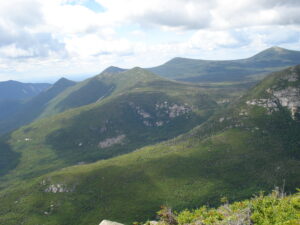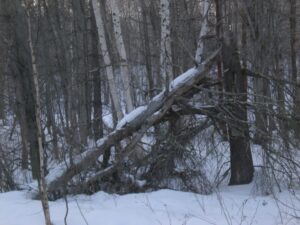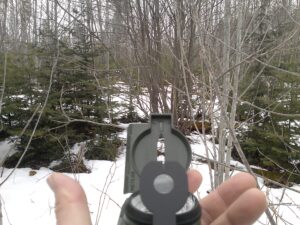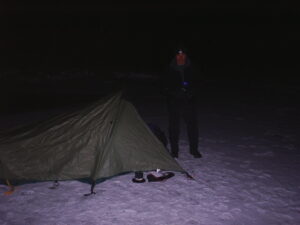In July of 2013 Geraldine Largay was hiking the Appalachian Trail in Maine by herself after her partner had to leave because of a family emergency. She was 66 years old and had a poor sense of direction and when she went off trail to use the bathroom she got lost and couldn’t find her way back. She tried to send a text using her cell phone, but there was no signal. Her remains were found two years later by a surveyor about two miles off the trail. Her journal is now shedding light on what happened. This is one of those stories that eats me up, because with just a little training it could have been avoided.
The Maine Woods
If you’re wondering how someone could walk a few steps off the trail and get completely lost allow me to offer an explanation. The northern Maine wilderness isn’t like the lovely forests that Thoreau wrote about in Walden Pond in Concord, Massachusetts. Those woods are thick and dark and beautiful and you must be on your guard because they are unforgiving of mistakes. The trees grow close together and walking through them can be like pushing through a rack of clothing at a department store where it’s so tight you literally have to put your head down and bull your way through to make progress. On several occasions I’ve walked through the woods around my house within feet of a trail and never saw it because of how dense the forest can be.
It would be easy to walk a little ways off the trail out of modesty to get out of sight of someone walking the trail behind you and then get turned around. You start walking in the direction you think the trail was, but you don’t see it. Second guessing yourself you turn back and walk a ways in the other direction. At first you’re a little nervous and feeling sheepish that you can’t find the stupid trail, then eventually you start to panic because you know you’ve walked three or four times the distance you walked in and now you know you’re lost. The trail could be five feet away at this point and it would easy to miss.
I know what it’s like to be in trouble in the area Geraldine was hiking in. As a matter of fact I broke my ankle on the trail in the 100 Mile Wilderness not too far from where she got lost. I too ran into the problem of not having cell phone coverage, but I wasn’t really surprised by this fact as we’d had limited coverage during most of the hike.
So what do you do if you get lost? Since she had a full pack lets assume that we have food for a few days and full equipment for a long term backpacking trip. This sets us up pretty good for survival.
Wilderness Survival Tips
1. STOP!
This is an acronym for Stop, Think, Observe, and Plan.
Stop: Stop moving. There’s a good chance that you’re feeling panic right after you first figure out that you’re lost. The urge is to run and find the trail. Don’t do it. Chances are good you’ll get even more lost or hurt yourself as you go flailing through the woods.
Think: Get your head going. Let the panic go. Once you start thinking you can:
Observe: Look around you. What can you see or hear? At this point hopefully you haven’t gone dashing through the woods looking for the trail. If so you’re probably still within sight or at least hearing distance of it even though you can’t see it. Take out a whistle and blow it sharply three times or yell every thirty seconds or so. Keep an eye out for people hiking. Listen for people hiking.
Plan: What’s your best course of action? Do you have a compass with you? Do you know how to read it? How much food and water do you have? Do you know where north is? Do you have a tent and sleeping bag?
2. Don’t trust electronics to save your life
Too many people today enter the wilds of America with the assurance that their cell phone, or GPS, or whatever will save them if they get in trouble. The truth is that if you trust your life to a piece of gear that runs on a battery or can die if it gets wet, then you are putting yourself in mortal danger without realizing it. In the woods here in Maine a cell phone signal is a luxury and there are no stores to replace batteries that have died. Take one with you for sure, but don’t pull it out expecting it to save your life. That way if it doesn’t work you won’t be disappointed.
3. Know how to use your gear
One of the saddest things about Geraldine’s situation is that she had a compass in her pack, but she didn’t know how to use it. If she could have spent an hour with me I could have showed her the basics of land navigation and she wouldn’t be dead right now. If you put a piece of gear in your pack know how to use it. A compass is not an ornament and when navigating from point to point it can save your life, but you must know how to use it.
4. Always have an emergency azimuth
Before going on a hike anywhere, you need to look at a map of the area where you’ll be operating in. Usually there will be a road, or a river, or some kind of land feature that will act as a handrail for where you’re hiking. For example, if you’re hiking a trail and there’s a road that parallels the trail five miles to the south, then south is your emergency azimuth.
If you wander off the trail, set 180 degrees on your compass and follow it until you hit the road. It might be a long five miles bushwhacking through dense forest, but if you follow the azimuth (or direction) you will eventually run into the road.
5. Always know where you are
As you move along the trail make sure you know where you are on the map. If you cross a stream or river find it on the map and you’ll know exactly where you are. If you’re hiking east and walk off the trail to your left what direction is that? If you said north then you’re well on your way to surviving. Let’s say you walk left (or north) far enough and lose sight of the trail and you want to find it again. Which direction would you follow on your compass to get back to the trail? If you said south congratulations, because you’ll find your way back to the trail and instead of it becoming a deadly situation this incident will just be a little blip on your day.
6. Leave a detailed hiking plan with someone
If there’s any one thing I’m guilty of not doing this is the one. Quite often I won’t hike a trail, but set out to bushwhack to a new place. Instead of saying, “I’m going to hike the trail up Ragged Mountain,” I’m more likely to say, “I’m going to follow an azimuth of 277 degrees magnetic until I get to the rockfall at the base of the mountain, then I’m going to hike 256 degrees to summit,” if I say anything at all. I pledge to be better in the future about leaving a detailed hiking plan with my wife before heading out. Either way, at least make sure someone has an idea of what general area you’ll be, because if you get hurt or lost they’ll have no idea where you are.
7. If you’re lost, make camp
This will prevent you from becoming even more lost. Geraldine was two miles off the trail, but in those woods it might as well have been 200. As soon as you figure out you’re lost, stop moving. Set up your tent and make yourself comfortable.
8. Signal
Start a fire in a clearing. Start it using dry wood then add leaves or green wood or whatever you can to make it smoke. The more smoke the better. Use a whistle to blow three sharp blasts from time to time. The louder the better. If you have a mirror use it signal aircraft that might be looking for you. Set up a bright colored poncho or one of those reflective emergency blankets in a clearing. Anything you can do to draw attention to yourself is good.
9. Remember the Survival Rule of 3’s
You can survive:
3 minutes without air
3 hours without shelter
3 days without water
3 weeks without food
These aren’t actual rules of course, but guidelines to help you organize your activities should you get lost. Thus, shelter is more important than food using this model. If you have a tent and sleeping bag, then you can move quickly along the priority list to water. Once you have a water source then you can start thinking about food.
10. Evaluate your situation and make a decision based on your facts. 
If after three days I haven’t been found or haven’t seen any sign of activity like a helicopter circling around looking I will probably try and self rescue, but that’s based on the fact that I’ve done a lot of wilderness survival, land navigation, backwoods hiking and camping, and have tons of experience. If you’re from the city and all you have is a couple of classes and a few hikes along well beaten trails under your belt, then you might want to sit tight. Carefully evaluate your situation. Ask yourself, “Does anybody know where I’m hiking?” If the answer is yes then you might want to stay put.
If the answer is no, then perhaps you’ll want to start moving. It’s hard to give a definitive answer because everybody’s situation is different. I probably would have advised Geraldine to sit tight because her husband had a good idea of where she was hiking and he would be able to alert the authorities to her general area. Unfortunately, she moved further off the trail looking for a cell phone signal and made it impossible for rescuers to find her.
Also Read: Maine Primitive Skills School Review
Each survival situation is different. The actual key here is to be as prepared as possible for any situation while out hiking. Other tips might be don’t hike alone if you’re a novice, carry a good first aid kit, and on and on. There are many things you need to take into consideration when going on a hike like the Appalachian trail and the more research you do and the more experience you gain the better off you’re going to be. I’ll leave you with this advice. Even though I’ve said it before it’s worth saying again: learn how to read a map and compass and if you put something in your pack know how to use it. It could save your life.
Questions? Comments?
Sound off below!
-Jarhead Survivor





13 comments
Jarhead, All of your survival rules are true. They would all save the life of anyone down in a wilderness. None of them would have saved this woman. This was a person that probably got lost in a Wal-Mart bathroom. Who obviously had nether a sense of direction or any slightest common sense, and who most likely spent her life time as a Darwin Award candidate. She was stupid and careless. The great forest kills and eats stupid and careless. Be it animal or man. Always has and always will. Training and equipment won’t fix that.
to be fair Ray, some of those bathrooms at Wal-Mart are pretty big…
Great info Jarhead. Important stuff that saves lives daily. Around here we might be tougher, but still death stalks the woods.
https://missoulian.com/news/state-and-regional/montana/man-killed-by-bear-had-plenty-of-backcountry-experience/article_dda2f307-f9dc-5bbb-ac73-6eac70c5d203.html
In the case linked above, a highly experienced outdoorsman and incredible athlete met his fate though a brief encounter that nobody could do anything about once it was in play. We’ve had a lot of rain here this spring so the hills are flush with tall plants. Just the other day I was zipping down a trail on my mountain bike (alone with zero survival equipment except a bike-oriented multitool) through a gauntlet of brush trying to knock me off my bike. Around a corner stood a deer using the same path. Luckily my encounter ended up with a short skid and a high jump by the deer.
In Denali, the rule is to stay off trails. To go right through the thick, and to avoid common pathways both to minimize encounters and to prevent building foot highways through the backcountry. That philosophy works very well, and I look forward to it when hiking there. However, below the 49th parallel, the park system demands that everyone stay on the trail. Animals are no different when it comes to taking the path of least resistance. Add the speed and quite of a mountain bike and bad things can happen fast.
The woman who got lost, in my mind, was light years ahead of all those who die of obesity-related illnesses. Making it 26 days is the “rule” as Jarhead pointed out. Not bad for someone four years shy of 70.
The survival literature is filled with antidotes about those who perished mere miles or even yards from salvation, and Mrs. Largay is no different. But don’t dismiss the death without adopting the takeaways beyond those obvious ones. Here’s a couple I thought of when reading the story:
1. Stay put, but set a deadline. Then move again. Conventional wisdom usually has a rescue within a couple days. Largay’s search ended in a week. So if the waiting doesn’t work, then get to work saving yourself. But of course that too can end badly as in this case:
https://www.theguardian.com/world/2016/feb/26/three-british-tourists-die-climbing-waterfalls-in-central-vietnam
2. Largay got to work, as she should, setting up camp and digging in. However, there is much more she could have done around camp. The details are sketchy, but, as Jarhead pointed out, signals and fire should be top priorities especially given the rough terrain. The Denali example above also illustrates that you can pass by a bear or lost hiker by 20 feet and never know each other was there.
3. Don’t be so shy. If you need to go 100 yards off the trail to pee, then you will become lost rapidly and often. Yea, guys have it easier, but if the foliage was so thick that loosing ones way is easy, then it should be easy to stay close to the trail for a quick squat in the dirt should.
and 4: Consider if Largay just bugged out. Perfect hiding spot. Nice camp. Ran out of food. So plan your bug out carefully. You are on borrowed time if only eating rations you carried in with you. The transition to sustainable food must happen fast and while you are in your best condition. If you wait till you have to eat before looking for food, your calendar just turned into countdown clock.
well, since you’ve brought it up Doc…
the “Authorities” failed Ms Largay.
yes, she should have read Angier, or her Girl scout Handbook… (she should have had it, with her)
“They” wrote her off weeks before she succumbed.
the lesson being: “They” might stop looking for low priority targets like “US” if we hold out long enough.
taking care of the clueless is an awesome responsibility.
Great info Jarhead. Important stuff that saves lives daily. Around here we might be tougher, but still death stalks the woods.
https://missoulian.com/news/state-and-regional/montana/man-killed-by-bear-had-plenty-of-backcountry-experience/article_dda2f307-f9dc-5bbb-ac73-6eac70c5d203.html
In the case linked above, a highly experienced outdoorsman and incredible athlete met his fate though a brief encounter that nobody could do anything about once it was in play. We’ve had a lot of rain here this spring so the hills are flush with tall plants. Just the other day I was zipping down a trail on my mountain bike (alone with zero survival equipment except a bike-oriented multitool) through a gauntlet of brush trying to knock me off my bike. Around a corner stood a deer using the same path. Luckily my encounter ended up with a short skid and a high jump by the deer.
In Denali, the rule is to stay off trails. To go right through the thick, and to avoid common pathways both to minimize encounters and to prevent building foot highways through the backcountry. That philosophy works very well, and I look forward to it when hiking there. However, below the 49th parallel, the park system demands that everyone stay on the trail. Animals are no different when it comes to taking the path of least resistance. Add the speed and quite of a mountain bike and bad things can happen fast.
The woman who got lost, in my mind, was light years ahead of all those who die of obesity-related illnesses. Making it 26 days is the “rule” as Jarhead pointed out. Not bad for someone four years shy of 70.
The survival literature is filled with antidotes about those who perished mere miles or even yards from salvation, and Mrs. Largay is no different. But don’t dismiss the death without adopting the takeaways beyond those obvious ones. Here’s a couple I thought of when reading the story:
1. Stay put, but set a deadline. Then move again. Conventional wisdom usually has a rescue within a couple days. Largay’s search ended in a week. So if the waiting doesn’t work, then get to work saving yourself. But of course that too can end badly as in this case:
https://www.itv.com/news/anglia/story/2016-06-09/man-missing-in-vietnam-found-dead/
2. Largay got to work, as she should, setting up camp and digging in. However, there is much more she could have done around camp. The details are sketchy, but, as Jarhead pointed out, signals and fire should be top priorities especially given the rough terrain. The Denali example above also illustrates that you can pass by a bear or lost hiker by 20 feet and never know each other was there.
3. Don’t be so shy. If you need to go 100 yards off the trail to pee, then you will become lost rapidly and often. Yea, guys have it easier, but if the foliage was so thick that loosing ones way is easy, then it should be easy to stay close to the trail for a quick squat in the dirt should.
4: Consider if Largay just bugged out. Perfect hiding spot. Nice camp. Ran out of food. So plan your bug out carefully. You are on borrowed time if only eating rations you carried in with you. The transition to sustainable food must happen fast and while you are in your best condition. If you wait till you have to eat before looking for food, your calendar just turned into countdown clock.
whenever I tell someone about the rule of threes, I usually throw in:
“… and three seconds of inattention” as the punchline.
We took a quick azimuth off the paved road just before heading into a small state park (26 sq miles ) for grouse season.
Chased one bird for awhile and then had to find the dog after it ran off chasing a rabbit.
The short winter day got us worried because we had no idea where we were. Thankfully we shot the same compass heading and wound up back on the paved road 2 miles from our jeep.
It was a little humbling walking back to the truck in the dark and honestly could have walked out of the small park in any direction, but was a good lesson for future trips up north.
People for the most part are as dumb as a box of rocks. Some friends wanted to walk down to a lower road in Death Valley an6d we agreed to drive down an6d pick them up. They had reached the road before we got there not noticed it since it was a dirt road and we saw them out on the flats heading out into the desert they didnot have water with them as it was heavy. Honking the truck horn got them to turn around and come back You could see for miles but they were blind as a bat not paying attention to what was around them
I’ve never thought of having lost in a wood one day and I’m not a type of an adventurous activity lover
Great article, very informative and useful. Actually, I think those knowledge and survival skill tips should be taught systematically at school. Everyone will need those basic survival skills somehow, and in some cases it makes the difference between life or death. I read lots of article about young people go on picnic without preparation and knowledge about wildlife and accidents happen. This will not happen if everyone is equipped with some basic survival skills.
Everyone going on a backwoods hiking trip needs to have a basic understanding of orienteering. Basic map and compass skills, and their own map and compass. It’s easy to get lost.
If you are the only person in your group of four to have orienteering skills and you get incapacitated… four people, rather than just one are now in danger of death.
Even an area with good solid trails can become confusing in the dark, or inclement weather, and leaving the trail for any reason can be disastrous for a novice. If they had basic skills, they have a much better chance than plain dumb luck.
Teaching basic skills to newbies is not optional… it’s mandatory. It can save their, and your life.